Control of Arabidopsis shoot stem cell homeostasis by two antagonistic CLE peptide signalling pathways
- PMID: 34643181
- PMCID: PMC8594942
- DOI: 10.7554/eLife.70934
Control of Arabidopsis shoot stem cell homeostasis by two antagonistic CLE peptide signalling pathways
Abstract
Stem cell homeostasis in plant shoot meristems requires tight coordination between stem cell proliferation and cell differentiation. In Arabidopsis, stem cells express the secreted dodecapeptide CLAVATA3 (CLV3), which signals through the leucine-rich repeat (LRR)-receptor kinase CLAVATA1 (CLV1) and related CLV1-family members to downregulate expression of the homeodomain transcription factor WUSCHEL (WUS). WUS protein moves from cells below the stem cell domain to the meristem tip and promotes stem cell identity, together with CLV3 expression, generating a negative feedback loop. How stem cell activity in the meristem centre is coordinated with organ initiation and cell differentiation at the periphery is unknown. We show here that the CLE40 gene, encoding a secreted peptide closely related to CLV3, is expressed in the SAM in differentiating cells in a pattern complementary to that of CLV3. CLE40 promotes WUS expression via BAM1, a CLV1-family receptor, and CLE40 expression is in turn repressed in a WUS-dependent manner. Together, CLE40-BAM1-WUS establish a second negative feedback loop. We propose that stem cell homeostasis is achieved through two intertwined pathways that adjust WUS activity and incorporate information on the size of the stem cell domain, via CLV3-CLV1, and on cell differentiation via CLE40-BAM1.
Keywords: A. thaliana; CLAVATA; CLE40; WUS; developmental biology; plant biology; shoot meristem; signalling; stem cells.
Plain language summary
Plants are sessile lifeforms that have evolved many ways to overcome this challenge. For example, they can quickly adapt to their environment, and they can grow new organs, such as leaves and flowers, throughout their lifetime. Stem cells are important precursor cells in plants (and animals) that can divide and specialize into other types of cells to help regrow leaves and flowers. A region in the plant called meristem, which can be found in the roots and shoots, continuously produces new organs in the peripheral zone of the meristem by maintaining a small group of stem cells in the central zone of the meristem. This is regulated by a signalling pathway called CLV and a molecule produced by the stem cells in the central zone, called CLV3. Together, they keep a protein called WUS (found in the deeper meristem known as the organizing zone) at low levels. WUS, in turn, increases the production of stem cells that generate CLV3. However, so far it was unclear how the number of stem cells is coordinated with the rate of organ production in the peripheral zone. To find out more, Schlegel et al. studied cells in the shoot meristems from the thale cress Arabidopsis thaliana. The researchers found that cells in the peripheral zone produce a molecule called CLE40, which is similar to CLV3. Unlike CLV3, however, CLE40 boosts the levels of WUS, thereby increasing the number of stem cells. In return, WUS reduces the production of CLE40 in the central zone and the organizing centre. This system allows meristems to adapt to growing at different speeds. These results help reveal how the activity of plant meristems is regulated to enable plants to grow new structures throughout their life. Together, CLV3 and CLE40 signalling in meristems regulate stem cells to maintain a small population that is able to respond to changing growth rates. This understanding of stem cell control could be further developed to improve the productivity of crops.
© 2021, Schlegel et al.
Conflict of interest statement
JS, GD, RW, KP, YS, JS, PB, RS No competing interests declared
Figures

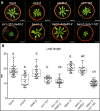

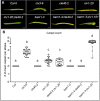
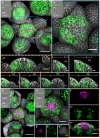

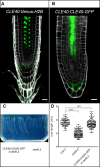
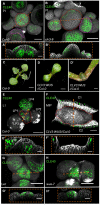




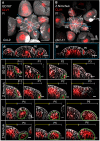

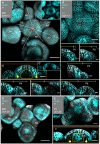
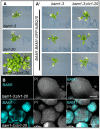



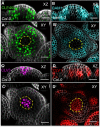

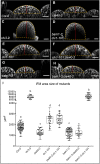



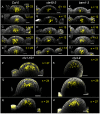







Similar articles
-
The CLAVATA signaling pathway mediating stem cell fate in shoot meristems requires Ca(2+) as a secondary cytosolic messenger.Plant J. 2016 Feb;85(4):494-506. doi: 10.1111/tpj.13123. Plant J. 2016. PMID: 26756833
-
Regulation of CLV3 expression by two homeobox genes in Arabidopsis.Plant Physiol. 2002 Jun;129(2):565-75. doi: 10.1104/pp.001867. Plant Physiol. 2002. PMID: 12068101 Free PMC article.
-
A group of receptor kinases are essential for CLAVATA signalling to maintain stem cell homeostasis.Nat Plants. 2018 Apr;4(4):205-211. doi: 10.1038/s41477-018-0123-z. Epub 2018 Mar 26. Nat Plants. 2018. PMID: 29581511
-
WUSCHEL in the shoot apical meristem: old player, new tricks.J Exp Bot. 2021 Feb 27;72(5):1527-1535. doi: 10.1093/jxb/eraa572. J Exp Bot. 2021. PMID: 33332559 Review.
-
WUSCHEL: The essential regulator of the Arabidopsis shoot Apical Meristem.Curr Opin Plant Biol. 2025 Jun;85:102739. doi: 10.1016/j.pbi.2025.102739. Epub 2025 May 16. Curr Opin Plant Biol. 2025. PMID: 40381531 Review.
Cited by
-
De novo stem cell establishment in meristems requires repression of organ boundary cell fate.Plant Cell. 2022 Nov 29;34(12):4738-4759. doi: 10.1093/plcell/koac269. Plant Cell. 2022. PMID: 36029254 Free PMC article.
-
Illuminating the molecular mechanisms underlying shoot apical meristem homeostasis in plants.Plant Biotechnol (Tokyo). 2022 Mar 25;39(1):19-28. doi: 10.5511/plantbiotechnology.22.0213a. Plant Biotechnol (Tokyo). 2022. PMID: 35800970 Free PMC article.
-
Coordination of shoot apical meristem shape and identity by APETALA2 during floral transition in Arabidopsis.Nat Commun. 2024 Aug 13;15(1):6930. doi: 10.1038/s41467-024-51341-6. Nat Commun. 2024. PMID: 39138172 Free PMC article.
-
Receptor-like protein kinases in plant reproduction: Current understanding and future perspectives.Plant Commun. 2021 Dec 29;3(1):100273. doi: 10.1016/j.xplc.2021.100273. eCollection 2022 Jan 10. Plant Commun. 2021. PMID: 35059634 Free PMC article. Review.
-
Peptide AEDL and Glutathione Stimulates Root Development Nicotiana tabacum.Int J Mol Sci. 2024 Dec 31;26(1):289. doi: 10.3390/ijms26010289. Int J Mol Sci. 2024. PMID: 39796141 Free PMC article.
References
-
- Alonso JM, Stepanova AN, Leisse TJ, Kim CJ, Chen H, Shinn P, Stevenson DK, Zimmerman J, Barajas P, Cheuk R, Gadrinab C, Heller C, Jeske A, Koesema E, Meyers CC, Parker H, Prednis L, Ansari Y, Choy N, Ecker JR. Genome-wide insertional mutagenesis of Arabidopsis thaliana. Science. 2003;301:653–657. doi: 10.1126/science.1086391. - DOI - PubMed
-
- Barbier de Reuille P, Routier-Kierzkowska AL, Kierzkowski D, Bassel GW, Schüpbach T, Tauriello G, Bajpai N, Strauss S, Weber A, Kiss A, Burian A, Hofhuis H, Sapala A, Lipowczan M, Heimlicher MB, Robinson S, Bayer EM, Basler K, Koumoutsakos P, Roeder AHK, Aegerter-Wilmsen T, Nakayama N, Tsiantis M, Hay A, Kwiatkowska D, Xenarios I, Kuhlemeier C, Smith RS. MorphoGraphX: A platform for quantifying morphogenesis in 4D. eLife. 2015;4:05864. doi: 10.7554/eLife.05864. - DOI - PMC - PubMed
Publication types
MeSH terms
Substances
Associated data
LinkOut - more resources
Full Text Sources
Other Literature Sources
Molecular Biology Databases
Research Materials

